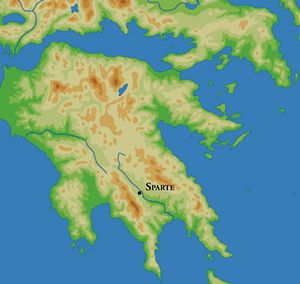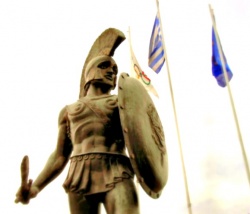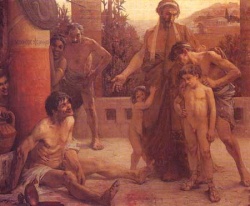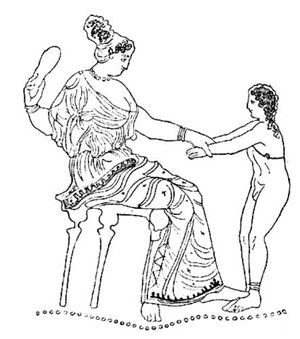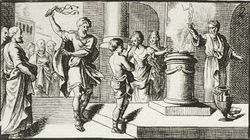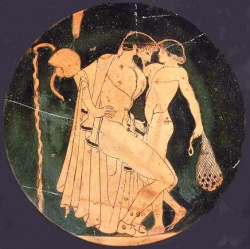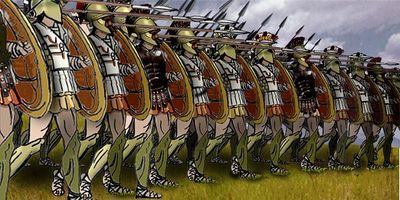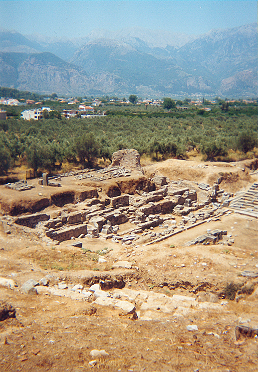Sparta
Sparta was a city-state in Ancient Greece from the 7th century BC until the Roman conquest of Greece. Sparta was a state with a rigidly hierarchical society devoted to military training. Sparta possessed the most formidable army in the Greek world, and after achieving notable victories over the Athenian and Persian Empires, regarded itself as the natural protector of Greece.
The city-state of Sparta was a collection of villages. Sparta also consisted of two territories around it called Laconia and Messenia. During the 6th and 5th centuries BC, the Spartan system was at its height. The population of Sparta was perhaps as much as 300,000 persons, about 30,000 of which were citizens and soldiers.
Society
Sparta was, above all, a militarist state, and emphasis on military fitness began virtually at birth. Shortly after birth, the mother of the child bathed it in wine to see whether the child was strong. If the child survived, the child's father brought it before the council of elders of the tribe for examination. If the baby was in any way defective, it was left on the wild slopes of Mt. Taygetos - also known as Apothetae, or as the Place of Rejection - to die. In this way the Spartans attempted the maintenance of high physical standards in their population. From the earliest days of the Spartan citizen, the claim on his life by the state was absolute and strictly enforced.
The Spartan constitution prescribed a system of education and living for Spartiates that was intended to promote bravery. Musical and athletic education were emphasized. Commercial activity, on the other hand, was strictly forbidden, and for most of its history Sparta had no coinage. Almost all luxuries were also forbidden, since it was believed that they undermined the discipline and training that would be needed for battle. Spartan men were not allowed to marry until late in life, and even then had to see their wives in secrecy. It is from the rigidly ascetic lifestyle that Spartiates led to satisfy these requirements that we obtain our present day word "Spartan," meaning ascetic.
The tireless emphasis on physical training gave Spartans the reputation for being 'laconic', economical with words, a word derived from the name of their homeland of Laconia. Education was also extended to girls, in the belief that strong and intelligent mothers would produce strong and intelligent children. Thus modern day historians, with the corroboration of ancient writers, tend to conclude that Spartan women were among the most educated in the ancient Greek world. Both sexes exercised nude and because of this a strong emphasis was placed on the physical fitness of men as well as women. Despite their physical fitness, women could not compete in the Olympic Games, according to the Olympic rules (they competed in the Heraea Games instead). There were also contests to see who could take the most severe flogging, an ordeal known as diamastigosis.
Structure of Spartan society
Spartan society in the classical period was rigidly divided into several castes, each with assigned duties and privileges. The smallest of these, with the most power and freedom, was the Spartiate elite. Spartiates were exempt from manual labor, and controlled the government of the state. Spartiate men were expected to prepare constantly for military conflict. Below the Spartiates were the Perioikoi, literally "dwellers around," inhabitants of outlying towns who carried out most of the trade and commerce of the city, since Spartiates were forbidden to engage in commercial activity. Further down the ladder were the helots, enslaved populations tied to the land and owned by the Spartan state. In the late 4th century and later, a new class, the neodamodeis (lit. 'new' damos dwellers), arose. It seems to have been composed of liberated helots. Also, there were the hypomeiones (lit. inferiors) men who were probably, although not certainly, Spartiates who had lost social rank.
Not all inhabitants of the Spartan state were considered to be citizens (part of Demos). Only the ones that had followed the military training, called the agoge, were eligible. However, usually the only people eligible to receive the agoge were Spartiates, or people who could trace their ancestry to the original inhabitants of the city. The helots made up 90 percent of the population. Due to the fact that descendants of non-Spartan citizens were not able to follow the agoge, and Spartans could lose their citizenship if they couldn't afford to pay the expenses of the agoge, the actual number of the Spartan citizens was constantly reduced.
Age 0-7
Fathers did not have authority over raising their offspring. Until the age of seven, children of both sexes were educated at home, by their mothers and/or by nurses. At the age of seven the boys were separated from their family and left home for military boarding school, called agoge. They were required to serve in the army from the age of seven to thirty.
Spartan women were famous for their childrearing skills and some were hired by rich families as nurses, e.g. the Spartan woman Amelia who nursed the Athenian Alkibiades.
Age 7-20: the agoge
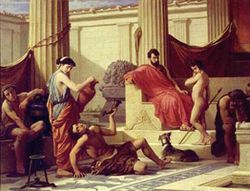
The term agoge (Άγωγή) literally translates as 'raising'. The aim of the system was to produce physically and morally steeled males to serve in the Spartan army. Training in the agoge was supervised by the paidonomos, an official appointed for that purpose who had the highest authority over the system.
Discipline and training in the agoge was extremely strict and harsh. The boys had to live in barracks and were underfed, thinly clothed, and regularly whipped, to teach them to bear pain without complaint. According to some sources, until age twelve, the boys would often not be allowed any clothes and then, only a cloak was provided. For sports, processions, dances and temple services, they were always naked.
The boys would only take a few baths a year and were bedded on the bare ground, without blankets, on top of straws and reeds. They would therefore often rub their bodies with thistles or put thistles in their pallet because the prickling sensation made them feel warmer. They would need to be fit, and were drilled with running, wrestling, and throwing quoits and javelins. They were also also taught to endure pain and hardship, hunger, thirst, cold, fatigue and lack of sleep. The young boys would have to go through what was known as the gauntlet. They would have to run around a group of older children, who would flog them continually with whips.
The boys were encouraged to fight amongst themselves in order to determine who was the strongest in the group. They were organized by age into mess halls called Agelai (meaning flock or herd), with the toughest boy set as the leader. The elders who ran the halls would set them upon each other to find out who was the best fighter. The children would be poorly fed, and told to steal to supplement their rations. However any boy who was caught stealing was severely whipped. It is believed that these punishments were not so much given for the act of stealing, but for getting caught.
Spartan pederasty
Spartan boys had little contact with their biological fathers. Instead, a form of institutionalised pederasty, claimed by some ancient historians to have been of a chaste nature, was practiced whereby older warriors would engage a youth in a long-lasting love relationship with a pedagogic purpose. The boy was expected to request the relationship, which was considered important in passing on knowledge and in maintaining loyalty on the battlefield. When sacrificing to a god before battle, the Spartans sacrificed to the god of love, Eros.
The Gymnopaedia
The Gymnopaedia was an annual summer festival of military activities and games for Spartan adolescents during which naked youths displayed their athletic and martial skills through the medium of dancing. The word Gymnopaedia is composed of γυμνός (gymnos - "naked") and παίς (pais - "child").
The custom was introduced early in the 7th century BC, concurrently with the introduction of naked athletics, oiling the body for exercise so as to highlight its beauty, and the formalization of pederastic pedagogy.
The festival lasted for several, perhaps ten, days and was celebrated in July in honor of Apollo Pythaeus, Artemis Orthia and Leto. The statues of these deities stood in a part of the Agora, and it was around these statues that the games and dance performances took place. Not surprisingly, there were whippings at the Gymnopaedia too. Youths were flogged until they bled, possibly meant as a blood sacrifice to Artemis Orthia. These whippings are also thought to have been a rite of passage for the young men and another event to demonstrate how tough they were.
The season of the Gymnopaedia was one of great merriment, and many strangers visited Sparte in this season. The Gymnopaedia became an important institution for gymnastic and orchestic performances, and for the cultivation of the poetic and musical arts at Sparta.
Age 20-30: the syssitia, krypteia, and marriage
At the age of 20, the Spartiate soldier left the Agoge and their Agelai. He then began his compulsory membership in one of the syssitia or pheiditia (dining messes or clubs), composed of about fifteen members each, where he would eat and sleep.
Young Spartan men who had completed their training at the agoge with such success that they were marked out as potential future leaders, would be given the opportunity to test their skills and prove themselves worthy of the Spartan military tradition through participation in the crypteia. This meant they had to survive with no shelter, clothing, or food, armed only with a small knife. They hid during the day and patrolled the helot land in the night like a sort of 'secret police' in search of potential revolts. Once the krypteia was complete, the Spartiates who survived it were given high standing in the army.
At the age of 20 the men were also expected to marry. A Spartan wedding was not highly ritualized and consisted of the intended bride being abducted with simulated violence. The bride's head would be shaved, and she was made to wear male clothing and lie on a straw pallet in the dark while her husband would wait until his friends had gone to sleep before leaving the barracks to do his duty and then returning before they were aware of his absence. After the wedding night the husband remained living in his barracks and would for many years have no daytime contact with his wife, only occasional nightly visits for the purpose of procreation.
Bachelorhood was frowned upon in Sparta and bachelors were the only people who were forbidden to watch the naked processions.
Age 30: full citizenship
At the age of 30, the military service ended, and the Spartiate became a full citizen with the right to vote. He would then also be able to take part in the Apella (the assembly of the people) and hold public office. A man was then also allowed to live together with his wife openly and to set up a household.
The role of women
Unusual for the Greek world, Spartan girls would also exercise their bodies by running, wrestling and throwing the discus and the javelin. It was thought that this strength will help women to withstand childbearing and wrestle with labour pains. The Spartans also believed that fit women gave birth to healthy babies, which made healthy warriors.
Albeit their education was not as harsh as the boys and they grew up with more freedom, Spartan girls were not allowed any 'female habits' such as sitting in the shade. It was custom for girls no less than boys to go naked in processions, and to sing and dance nude at festivals, even while men were present and looking on. Girls and women probably lived with their mother until they were married, but could not live with their husbands for 10 or more years later.
Spartan women did no work other than raising children. They enjoyed a status, power and respect that was unknown in the rest of the classical world, as well as the modern world in some respects. They controlled their own properties, as well as the properties of male relatives who were away with the army. It is estimated that women were the sole owners of at least 40% of all land and property in Sparta. The laws regarding a divorce were the same for both men and women. Unlike women in Athens, if a Spartan woman became the heiress of her father because she had no living brothers to inherit, the woman was not required to divorce her current spouse in order to marry her nearest paternal relative. Spartan women received as much education as men, as well as a substantial amount of physical education and gymnastic training. They rarely got married before the age of 20, and unlike Athenian women who wore heavy, concealing clothes and were rarely seen outside the house, Spartan women wore short dresses and went where they pleased.
When a foreigner said to Gorgo, the wife of king Leonidasher, 'You Spartans are the only women who rule over their men', she replied, 'Because only we are the mothers of men'.
The revival of Spartan ideals
The Spartan educational system inspired the founders of the English public schools like Eton and Harrow. They set out to teach their pupils a code of discipline and devotion to duty, toughening them up with competitive sports, corporal punishments and cold showers.
Adolf Hitler considered Sparta to be the first National Socialist state, and praised its early eugenics treatment of deformed children. The Hitler Youth was in part based on Spartan ideals and methods.
See also
Links
Chat rooms • What links here • Copyright info • Contact information • Category:Root
